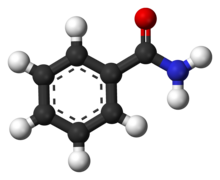
| |

| |
| Names | |
|---|---|
| Preferred IUPAC name
Benzamide[1] | |
| Systematic IUPAC name
Benzenecarboxamide | |
| Other names
Benzoic acid amide
Phenyl carboxamide Benzoylamide | |
| Identifiers | |
3D model (JSmol)
|
|
| 3DMet | |
| 385876 | |
| ChEBI | |
| ChEMBL | |
| ChemSpider | |
| ECHA InfoCard | 100.000.207 |
| EC Number |
|
| KEGG | |
PubChem CID
|
|
| RTECS number |
|
| UNII | |
CompTox Dashboard (EPA)
|
|
| |
| |
| Properties | |
| C7H7NO | |
| Molar mass | 121.139 g·mol−1 |
| Appearance | Off-white solid |
| Density | 1.341 g/cm3 |
| Melting point | 127 to 130 °C (261 to 266 °F; 400 to 403 K) |
| Boiling point | 288 °C (550 °F; 561 K) |
| 13.5 g/L (at 25°C)[2] | |
| Acidity (pKa) | |
| -72.3·10−6 cm3/mol | |
| Pharmacology | |
| N05AL (WHO) | |
| Hazards | |
| GHS labelling: | |
 
| |
| Warning | |
| H302, H341 | |
| P201, P202, P264, P270, P281, P301+P312, P308+P313, P330, P405, P501 | |
| NFPA 704 (fire diamond) | |
| Flash point | 180 °C (356 °F; 453 K) |
| > 500 °C (932 °F; 773 K) | |
Except where otherwise noted, data are given for materials in their standard state (at 25 °C [77 °F], 100 kPa).
| |
Benzamide is an organic compound with the chemical formula of C7H7NO. It is the simplest amide derivative of benzoic acid. In powdered form, it appears as a white solid, while in crystalline form, it appears as colourless crystals.[5] It is slightly soluble in water,[2] and soluble in many organic solvents.[6] It is a natural alkaloid found in the herbs of Berberis pruinosa.[6]
Chemical derivatives[edit]
A number of substituted benzamides are commercial drugs, including:
- Analgesics
- Antidepressants
- Antiemetics/Prokinetics
- Alizapride
- Batanopride
- Bromopride
- Cinitapride
- Cisapride
- Clebopride
- Dazopride
- Itopride
- Metoclopramide
- Mosapride
- Prucalopride
- Renzapride
- Trimethobenzamide
- veralipride
- Zacopride
- Antipsychotics
- Opioids
- Others
- 3-Aminobenzamide
- aminohippuric acid
- Chidamide
- Denipride
- Entinostat
- Eticlopride
- imatinib
- Mocetinostat
- Procarbazine
- Pyramide (pyridinyl ethylbenzimide)[7]
- Raclopride
- Sunifiram
See also[edit]
- ATC code N05AL Benzamides – Pharmaceutical drug classification
References[edit]
- ^ Favre, Henri A.; Powell, Warren H. (2014). Nomenclature of Organic Chemistry : IUPAC Recommendations and Preferred Names 2013 (Blue Book). Cambridge: The Royal Society of Chemistry. p. 841. doi:10.1039/9781849733069-FP001. ISBN 9780854041824. OCLC 1077224056. Archived from the original on 2022-10-11. Retrieved 2022-10-11.
- ^ a b "Benzamide | 55-21-0 supplier and manufacturer". BuyersGuideChem. Archived from the original on July 29, 2017. Retrieved October 11, 2022.
- ^ Haynes, William M., ed. (2016). CRC Handbook of Chemistry and Physics (97th ed.). CRC Press. p. 5–89 [sic]. ISBN 9781498754286. OCLC 1012162798. Archived from the original on 2022-10-11. Retrieved 2022-10-11. page cited is 5-89, not 5 to 89
- ^ Bordwell, Frederick G.; Ji, Guo Zhen (October 1991). "Effects of structural changes on acidities and homolytic bond dissociation energies of the hydrogen-nitrogen bonds in amidines, carboxamides, and thiocarboxamides". Journal of the American Chemical Society. 113 (22): 8398–8401. doi:10.1021/ja00022a029. Archived from the original on 2020-12-11. Retrieved 2022-10-11.
- ^ CID 2331 from PubChem
- ^ a b "benzamide, CAS number 55-21-0". The Good Scents Company. Retrieved October 11, 2022.
- ^ Kent, James A.; Singh, K. N.; Merchant, Kavita (2012). "The Agrochemical Industry, Annex 17.1". In Kent, James A. (ed.). Handbook of Industrial Chemistry and Biotechnology. New York: Springer Verlag. pp. 643–698. doi:10.1007/978-1-4614-4259-2_17. ISBN 9781461442592. OCLC 1097100876. Archived from the original on 2022-10-11. Retrieved 2022-10-11.

Well, that’s interesting to know that Psilotum nudum are known as whisk ferns. Psilotum nudum is the commoner species of the two. While the P. flaccidum is a rare species and is found in the tropical islands. Both the species are usually epiphytic in habit and grow upon tree ferns. These species may also be terrestrial and grow in humus or in the crevices of the rocks.
View the detailed Guide of Psilotum nudum: Detailed Study Of Psilotum Nudum (Whisk Fern), Classification, Anatomy, Reproduction